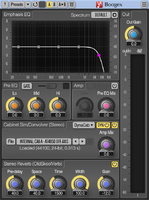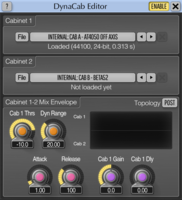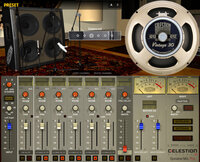The problem: Static Cabinet Impulse Responses
In the not-too-distant past, anyone wanting to create a realistic electric guitar tone inside their DAW would use an amplifier simulator plugin (amp sim) combined with a cabinet impulse response loader (IR loader). Fortunately, most modern amp sims feature a built-in IR loader, which makes the process more streamlined. But these built-in IR loaders can often be turned off, thereby allowing the use of an external IR loader. And why would you want to do that...? Read on!
For those not in the know, an amp sim is a DAW plugin that attempts to simulate the circuitry of a tube-based (or sometimes solid state) guitar amplifier. Often they are modeled after real-world guitar amplifiers, but not always.
Cabinet IRs are small sound files that are loaded into an IR loader. The IR loader is then placed after an amp sim in an attempt to simulate the tone qualities of a guitar cabinet. This is an important step as guitar cabinets have a significant effect on an electric guitar’s timbre.
For the curious, here’s how to create a cabinet IR:
1) Select a guitar cabinet. Speaker type and cabinet type all affect tone.
2) Select a microphone. Microphone models affect tone.
3) Position the microphone in front of the guitar cabinet. Microphones positioned closer to a speaker’s cap (the circular bit in the middle) generally sound bright, while microphones positioned closer to the edge of a speaker’s cone generally sound dark. Many other positions, angles, and distances are also possible, providing a myriad of results.
3) Inject a sine-sweep into the cabinet and record the resulting speaker output with the aforementioned microphone. The sweep is usually from 20 Hz to 20000 Hz, thereby covering the full range of human hearing.
4) Process the recorded output with deconvolution software, such as Deconvolver by Voxengo.
Once the above has been completed you will have a short audio file, often in the .wav format, which can be loaded into any IR loader. Some IR loaders are designed to work only with guitar cabinet IRs, such as the free NadIR from Ignite Amps; whereas others are more general purpose and may even be included with your DAW, such as Fruity Convolver in FL Studio or ReaVerb in Reaper, the latter of which also includes deconvolution capabilities.
As of this writing, cabinet IRs are the most common way to make the output of an amp sim sound “realistic.” However, there is one major problem with this method. Any IR created using the above method will be nothing more than a static snapshot of a speaker’s frequency response.* In the real world, speakers have a dynamic frequency response, something that standard cabinet IRs do not reproduce.
Why do speakers have a dynamic frequency response? I have not yet found a clear and concise exploration of this topic, but there are likely several factors involved. Perhaps the most important factor is that speaker cones do not accelerate and decelerate uniformly when reproducing sound waves. This results in some frequencies being propagated before others, thereby creating subtle phase shifts in the reproduced audio signal, as well as differently affecting amplitude across the frequency spectrum. And as the aggregate signal becomes louder, these issues become more pronounced and/or change in characteristic.** Other factors may include the frequency-dependent reactance of the speaker’s voice coil, and the subsequent interaction between the amplifier’s impedance rating and the dynamic impedance of the speaker. But once again, I haven’t found any good articles on this topic and how it relates to cabinet IRs.
*Cabinet IRs also capture the frequency response of the microphone, as well as the nuances of the cabinet itself. As a result, cabinet IRs are often sold in packs with specific cabinet, speaker, and microphone combinations, and often with multiple IRs for every combination, each created using different microphone positions.
**Remember, loudness does not always mean the volume knob, but also the inherent peaks and valleys of any given audio signal.
In the not-too-distant past, anyone wanting to create a realistic electric guitar tone inside their DAW would use an amplifier simulator plugin (amp sim) combined with a cabinet impulse response loader (IR loader). Fortunately, most modern amp sims feature a built-in IR loader, which makes the process more streamlined. But these built-in IR loaders can often be turned off, thereby allowing the use of an external IR loader. And why would you want to do that...? Read on!
For those not in the know, an amp sim is a DAW plugin that attempts to simulate the circuitry of a tube-based (or sometimes solid state) guitar amplifier. Often they are modeled after real-world guitar amplifiers, but not always.
Cabinet IRs are small sound files that are loaded into an IR loader. The IR loader is then placed after an amp sim in an attempt to simulate the tone qualities of a guitar cabinet. This is an important step as guitar cabinets have a significant effect on an electric guitar’s timbre.
For the curious, here’s how to create a cabinet IR:
1) Select a guitar cabinet. Speaker type and cabinet type all affect tone.
2) Select a microphone. Microphone models affect tone.
3) Position the microphone in front of the guitar cabinet. Microphones positioned closer to a speaker’s cap (the circular bit in the middle) generally sound bright, while microphones positioned closer to the edge of a speaker’s cone generally sound dark. Many other positions, angles, and distances are also possible, providing a myriad of results.
3) Inject a sine-sweep into the cabinet and record the resulting speaker output with the aforementioned microphone. The sweep is usually from 20 Hz to 20000 Hz, thereby covering the full range of human hearing.
4) Process the recorded output with deconvolution software, such as Deconvolver by Voxengo.
Once the above has been completed you will have a short audio file, often in the .wav format, which can be loaded into any IR loader. Some IR loaders are designed to work only with guitar cabinet IRs, such as the free NadIR from Ignite Amps; whereas others are more general purpose and may even be included with your DAW, such as Fruity Convolver in FL Studio or ReaVerb in Reaper, the latter of which also includes deconvolution capabilities.
As of this writing, cabinet IRs are the most common way to make the output of an amp sim sound “realistic.” However, there is one major problem with this method. Any IR created using the above method will be nothing more than a static snapshot of a speaker’s frequency response.* In the real world, speakers have a dynamic frequency response, something that standard cabinet IRs do not reproduce.
Why do speakers have a dynamic frequency response? I have not yet found a clear and concise exploration of this topic, but there are likely several factors involved. Perhaps the most important factor is that speaker cones do not accelerate and decelerate uniformly when reproducing sound waves. This results in some frequencies being propagated before others, thereby creating subtle phase shifts in the reproduced audio signal, as well as differently affecting amplitude across the frequency spectrum. And as the aggregate signal becomes louder, these issues become more pronounced and/or change in characteristic.** Other factors may include the frequency-dependent reactance of the speaker’s voice coil, and the subsequent interaction between the amplifier’s impedance rating and the dynamic impedance of the speaker. But once again, I haven’t found any good articles on this topic and how it relates to cabinet IRs.
*Cabinet IRs also capture the frequency response of the microphone, as well as the nuances of the cabinet itself. As a result, cabinet IRs are often sold in packs with specific cabinet, speaker, and microphone combinations, and often with multiple IRs for every combination, each created using different microphone positions.
**Remember, loudness does not always mean the volume knob, but also the inherent peaks and valleys of any given audio signal.



